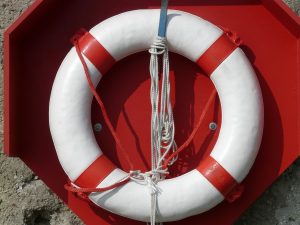
4 Things You Can Do When the Chaos Around You Gets in Your Head
The world is descending towards chaos and the prognosis isn’t great. Even the Apocalypse preachers are getting louder. (But that’s another article.) Meanwhile, if you’re like me, there’s enough happening in your personal life clamoring for your attention that you feel like you might drown under it all. What to do?
1) Float

I was twenty years old before I learned how to swim. But I loved canoeing and being on and around water, so I learned to float in my early teens. When I finally took a beginning swim class in college, that was the first thing our instructors taught us. Almost everyone can simply lie on their back, extend their arms and legs out, and float with their nose above the water.
When everything feels like it’s too much, the demands are coming from all sides, and you can’t find a direction in the whirlwind, that’s when it’s appropriate to step back, break away, take a few deep breaths and chill.
Turn your phone off. Walk outside or down the hall or to another floor in your building. (I once moved 1500 miles for a change, but that usually isn’t necessary!) I will turn off all the TVs in the house, close my computer or tablet, leave the phone behind and go outside or to a different room. Even if all you can do is lock yourself in the bathroom or a closet for three minutes to do some controlled breathing and let go of the emotions, it helps.
If you catch it early, this kind of floating can quickly stop the clamor and get you back on a thinking track instead of the emotional roller coaster. But the situation(s) that caused the flood often hang around or are long-term, so you need more.
2) Tread Water
I said “almost everybody” above, because some people can’t float. A fellow student in my class was a young man who was a light-weight wrestler, all muscle and bone. He sank to the bottom. So, he learned to tread water before the rest of us.
Treading water puts your whole head above the wet, so you can look around. The problem with treading water is that it takes a lot of energy without going anywhere. Other than taking a moment to assess the situation, staying here isn’t a viable option.
3) Grab a Life Preserver

Similar to floating, a life preserver allows you to keep your face out of the water and usually your whole head. There are various forms, shapes and sizes, but they all can keep you afloat even if you are injured or unconscious. They may even be enough to allow you to dog paddle to safety.
Here’s an example: A good friend called me last night, needing a friend to listen and brainstorm solutions for a family problem. When I touched base with her today, the most time-critical portion was resolved. Her call was a life preserver, letting her both vent and clarify.
Calling a babysitter to get out of the house, getting a massage or mani-pedi, meeting with a friend over coffee, date-night with your spouse, or talking with a mentor can all be life preservers. Be sensitive, though, in choosing with whom you spend your time. Going out with your drinking buddies or “therapy shopping” isn’t going to help. Nor is that person who always makes it about themselves.
My husband and I talk every night, even when he’s on the road. We try to give each other the time needed to dump the frustrations of the day. But we have also learned that if things start to get too tense, whether the subject is budget, politics, family or the dog, one of us calls a halt and that discussion is tabled until the weekend when we aren’t tired. It’s amazing how many “issues” disappear that way!
Yes, a life preserver can be a person, action, or even an attitude, but it’s something you choose.
4) Call the Coast Guard

When life brings a flood or hurricane, it’s time to bring in the trained professionals. Before you panic, understand that many types of people wear that hat.
Your Primary Care Physician – It amazes me how integrated our bodies, minds, and spirits are. This is a good place to start if you think/know you have physical issues.
Don’t discount something just because it’s inconvenient or seems unrelated. When I was a kid, my dad was having a lot of problems with his knee. Since his job involved doing a lot of climbing around, using a cane was not a long-term solution. Then he discovered he had an abscessed tooth and had all of his teeth pulled (early 1960s). His knee got better. The infection from his abscess had traveled.
Also be prepared to re-examine medications you already take with their side-effects & interactions. Even if you’re considering adding something, this is a good place to start. But that also means you need to be able to talk frankly with your doctor or physician’s assistant and trust they will listen.
Counselors, Psychiatrist, Programs — When I hit my rock bottom twenty-five years ago, I started with my doctor. He put me on a low dose anti-depressant for six weeks and told me to look for counseling. I had already decided I wanted to cover my bases, so I reached out to a pastor whom I knew was specifically trained in counseling. His slate was full, but he put me in touch with someone who wouldn’t blink at my talking/ranting to and about God.
When the meds had no effect, my doctor sent me to a psychiatrist. “They have the expertise and knowledge for all the new stuff that I don’t.” I will be forever grateful for his attitude.
Different storms require different emergency responses. Addiction, suicidal thoughts, the blahs, panic attacks aren’t all treated the same. Two people with the “same” problem won’t necessarily have the same path out of the quagmire. And that’s just fine.
I have used all of the above steps at one time or another in my life. Even all four at once. Having finally learned how to swim, more and more I’m able to spend my time with floating or with a life preserver to get back on track until I get to shore. I’ve also gotten better at identifying when I need professional help, although the last time took one of my doctors to point it out.
The key is knowing that you have choices.
- You can choose to let Life push you around and feel helpless.
- You can choose to change your attitude and approach the challenges with deliberate thinking and action or non-reactivity.
- You can also add a more spiritual approach, which for me means making my choices within the context of knowing God walks beside me and — even when I mess up — won’t let me go. That removes the pressure of perfectionism and judgement. I can view others as on the same kind of journey and treat them with the same kindness and respect I want.
Because while we may seem alone in our individual storms, there are larger storms we all must face. But we don’t have to face them alone. When we join our individual life preservers into rafts, and rafts into boats, we go beyond weathering the storm. We harness the winds and waves for the benefit of all.
To borrow an old sailing blessing:
Fair Winds and Following Seas!
